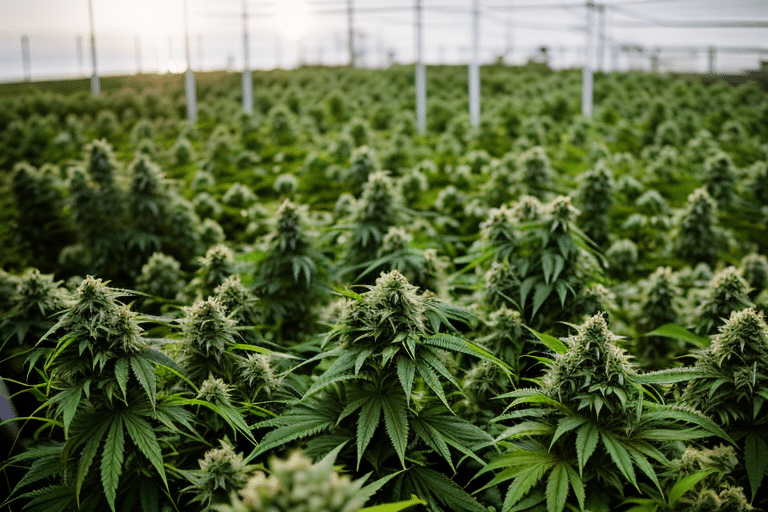As cannabis has become legal in many parts of the United States, new products appear on the market practically every day. One novel cannabis product is delta-8.
Because of a legislative loophole, delta-8 THC is legal in most of the United States despite its sibling cannabinoid delta-9 remaining illegal. However, some states are starting to increase restrictions on delta-8 as well. This explains why delta-8 products like edibles can still be sold in states where cannabis is illegal.
As more people discover delta-8 at local gas stations and drug stores, many wonder how this drug differs from cannabis and its effects when mixed with other substances. Is it possible to mix delta-8 and alcohol without catastrophic consequences?
While there is always some inherent risk to mixing substances, understanding the potential repercussions of these combinations can help you make the right choices. Let’s look at what science tells us about this combination.
Table of Contents
ToggleWhat is Delta-8?
Before diving too deep, it’s important to have a deeper understanding of what delta-8 is and how manufacturers use it to make the products that are becoming popular nationwide.
While delta-8 and delta-9 THC have received different legislative treatments, they are similar compounds. Delta-8 and delta-9 are both naturally occurring cannabis compounds present in cannabis. However, they appear in very different proportions within cannabis.
While delta-9 is the key cannabinoid in a cannabis plant, delta-8 occurs in small doses and lower concentrations. To create the delta-8 products appearing in stores nationwide, manufacturers extract the substance from cannabis plants and concentrate the dosage. As a result, the overall psychoactive effect when consuming delta-8 products is similar to regular THC.
Many delta-8 users argue that its effects are milder and safer. Because of its chemical structure, the delta-8 cannabinoid makes THC side effects like anxiety and paranoia much less probable. You can think of delta-8 as “THC light” and might consider using it more if your experiences with regular THC have been too intense.
But what about combining delta-8 and alcohol? To understand this interaction, let’s see what studies say about the effects of THC in combination with other substances.
Mixing Substances: What Does Science Say?
While studies about cannabis are becoming more common as the drug’s legality expands, only a few credible studies provide conclusive data about the interaction of THC and alcohol in the body. These studies can also give us some insight on how delta-8 might interact with alcohol.
One of these studies was a 1992 experiment aimed at understanding whether alcohol enters the bloodstream of a THC user differently.[1] In this study, 15 healthy adult males, all self-identified casual marijuana users, received one of three different controls: a low dose of THC, a high dose of THC, or a placebo. Participants would receive their substance and drink each week while the team measured the results. This study found that even after consuming a high dose of alcohol, the THC slowed down its absorption into the bloodstream and even delayed feelings of drunkenness.
A 1988 study tested marijuana and alcohol’s impact on psychomotor performance or the relationships between cognitive process and motor function.[2] In this study, participants consumed THC first, followed by alcohol. Despite the variety of participants and control groups used for the analysis, the results were significant. Regardless of the amount, the marijuana and alcohol reacted synergistically. In other words, the effects of one heightened the impact of the other.
A 2015 study looked specifically at delta-9 vapes and alcohol.[3] The researchers found that consuming even a small dose of alcohol after vaping delta-9 heightened the effects of THC, decreasing concentration and motor skill function beyond normal levels.
Do you need custom private label Delta 8 products produced for your CBD business?
SEE WHAT WE CAN DO
Do you need custom private label Delta 8 products produced for your CBD business?
SEE WHAT WE CAN DO
What Does This Mean for Me?
While these studies looked specifically at delta-9 rather than delta-8, the absorption pattern between the cannabinoids is nearly identical. Therefore, it’s safe to assume that consuming any form of THC with alcohol will always have risks and could cause any effects found in the studies above.[1][2][3]
One important feature to observe, though, is the order of events. The experience changes depending on whether one consumes delta-8 or alcohol first.
Consuming alcohol first is likely to increase the absorption of THC into the bloodstream. Therefore, if you are already drinking but can’t yet feel the alcohol’s effects, be careful with the amount of delta-8 or any THC product that you use. Combining THC this way could make you far more susceptible to an overdose or “green out.” While it is impossible to die from a green out, it could cause unpleasant vomiting, nausea, or dissociative effects.
Consuming delta-8 first and then drinking could be even more precarious. While green outs can’t cause death, alcohol poisoning certainly can. As noted in the 1992 study, drinking after already being high can mitigate the effects of alcohol and delay feeling drunk.[1] Therefore, combining alcohol after using delta-8 could cause you to drink too much accidentally and even lead to alcohol poisoning. Take increased caution if you decide to use these substances in this order.
Overall, the data suggest a risk of combining any substances. When combining delta-8 and alcohol, remember that everyone will react differently to this combination. A person’s reaction depends on drug and alcohol use history, height, weight, age, and genetics. Pay attention to how you feel, remember to start slow, and know that you can always say no.
Using Delta-8 Responsibly
One of the best ways to protect against an unwanted reaction while intoxicated is to know what you’re using and how to use it responsibly. Because delta-8 is not heavily regulated, the quality of products varies greatly and can significantly impact your experience. When using delta-8, follow our best use practices to keep yourself and your friends out of harm’s way.
Delta-8 Best Use Practices:
● Slow and steady wins the race. Using a drug like delta-8 is not a competition to see who can get the highest or feel the effects quickest. Keep in mind the form you are taking. If you’re using edibles, give yourself at least 45 minutes to an hour to feel the effects of delta-8 before taking more.
● Moderation is key. Although delta-8 and THC are not highly addictive substances, monitoring your relationship with the drug is essential. It’s wise to keep track of how often you use delta-8. Also, make sure your drug use aligns with your values and isn’t infringing on other parts of your life. If you want to stop using but can’t quite figure out how, there are resources for you. Contact your healthcare provider or the Substance Abuse and Mental Health Services Administration (SAMHSA) anonymous hotline at 800-662-4357.
● Under the influence, out of commission. It’s important not to operate any machinery or vehicles while under the influence of delta-8, alcohol, or any other substance that inhibit motor skills and cognitive ability. Keep yourself and others safe by having a sober friend available if you need something throughout your experience.
● Know your limits. If you’ve had bad experiences with delta-8 in the past or take medications that advise against drug and alcohol consumption, talk to your doctor before using. Delta-8 and alcohol may not fit into your life right now.
● Be prepared. Accidents happen, and people sometimes go too far. Being informed and prepared to address these situations makes them much less stressful should they arise. Review our section below to learn how to respond if someone you’re around is greening out.
Signs of Greening Out and How To Respond
As previously mentioned, greening out is the colloquial term for a THC overdose. When someone starts greening out, it can quickly become a stressful situation if you’re not informed about what is happening.
While many of the physical manifestations of a green out may be unpleasant, they aren’t fatal. Some of the most apparent signs of greening out are a sudden mood change, nausea, vomiting, sweating, shivering, anxiety, and paranoia. You can alleviate the impact of greening out by hydrating, relaxing, and eating. If someone starts to green out, do your best to stay calm and get them what they need. Heightened reactions are likely to cause more anxiety than necessary.
It’s also essential to understand the difference between greening out and alcohol poisoning. Recall that using THC products and alcohol together can sometimes inhibit your ability to feel drunk. As a result, it is quite possible to drink too much without feeling the effects of overconsumption.
Combining substances is tricky as many symptoms of alcohol poisoning are the same as greening out. Unlike greening out, alcohol poisoning can be life-threatening. If you or a friend experience uncontrollable vomiting, unconsciousness, confusion, seizures, low body temperature, blue lips or skin, and slow or irregular bleeding, it might be time to call 911.
Though it is tempting to lie about your consumption due to embarrassment or fears of negative repercussions, it’s critical to be honest about your drug and alcohol use so that first responders and medical professionals can treat you appropriately. Laws in many states protect you against legal implications if the truth helps save someone’s life.
Be Safe and Have Fun!
While understanding all the possible pitfalls of using substances can feel daunting, remember that knowledge is power. Understanding how to respect substances like delta-8 and alcohol is essential. Remember to use substances with people who make you feel comfortable and in safe environments.
Using substances like delta-8 and alcohol appropriately and in moderation should enhance your life rather than endanger it.
References
[1] https://pubmed.ncbi.nlm.nih.gov/1326277/ [2] https://pubmed.ncbi.nlm.nih.gov/2837105/ [3] https://academic.oup.com/clinchem/article/61/6/850/5611427







